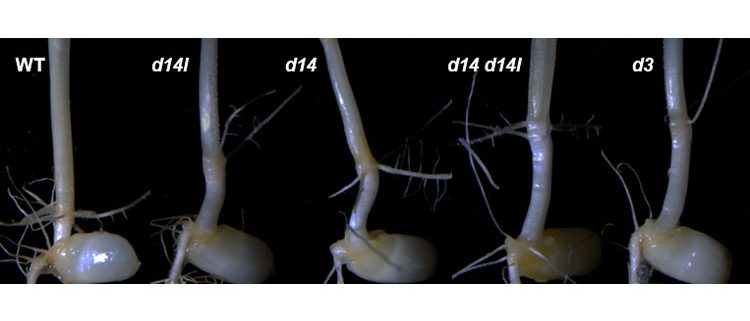Karrikins and Strigolactone Signaling in Monocots
Zheng et al. demonstrate how monocot plants sense karrikin, a smoke-derived chemical. Plant Cell https://doi.org/10.1105/tpc.20.00123
By J Zheng, K Hong, L Zeng, S Kang and G Xiong
Background: Seedling emergence in rice depends mainly on mesocotyl elongation, which is precisely regulated by the integration of developmental signals and environmental stimuli. Karrikins are small molecules found in smoke from wildfires, with a molecular structure similar to that of the D-ring of strigolactones. Both karrikins and strigolactones can negatively regulate Arabidopsis hypocotyl and rice mesocotyl development. Either deficiency in karrikins or in strigolactone perception and signal transduction lead to the Arabidopsis hypocotyl elongation in the light and the rice mesocotyl elongation in the dark.
Question: We wanted to know if karrikin signaling transduction in monocots is similar to that in dicots. We also wanted to know whether the karrikin signaling module also acts as the strigolactone signaling module in plants. In previous studies, genetic evidence suggested that this might be the case, but biochemical support for this hypothesis was lacking.
Findings: We found that karrikins induce the ubiquitination and degradation of OsSMAX1, a homolog of D53, requiring the function of D14L and D3. The increase of OsSMAX1 abundance promotes mesocotyl elongation, while the decrease of OsSMAX1 abundance represses mesocotyl elongation. We showed that OsSMAX1, acting downstream of D14L and D3, interacts with transcriptional co-repressor to regulate expression of downstream genes. Moreover, we found that strigolactones specifically act through a D14-D3-D53 module, regulating mesocotyl elongation as well as shoot branching, whereas karrikins specifically use a D14L-D3-OsSMAX1 module to control mesocotyl elongation without shoot branching. Our work reveals that karrikins and SLs are able to specifically and additively regulate downstream gene expression during rice mesocotyl development in darkness.
Next steps: We are working on finding the transcription factors that mediate the regulation of downstream gene expression in response to karrikins and strigolactones. Further research will explore the combination between D53/SMXL proteins and various transcription factors. These results help to illuminate how the developmental program and environmental adaptation are integrated in response to karrikins and strigolactones in plants.
Jianshu Zheng, Kai Hong, Longjun Zeng, Lei Wang, Shujing Kang, Minghao Qu, Jiarong Dai, Linyuan Zou, Lixin Zhu, Zhanpeng Tang, Xiangbing Meng, Bing Wang, Jiang Hu, Dali Zeng, Yonghui Zhao, Peng Cui, Quan Wang, Qian Qian, Yonghong Wang, Jiayang Li & Guosheng Xiong. (2020). Karrikin Signaling Acts Parallel to and Additively with Strigolactone Signaling to Regulate Rice Mesocotyl Elongation in Darkness. Plant Cell. https://doi.org/10.1105/tpc.20.00123.




